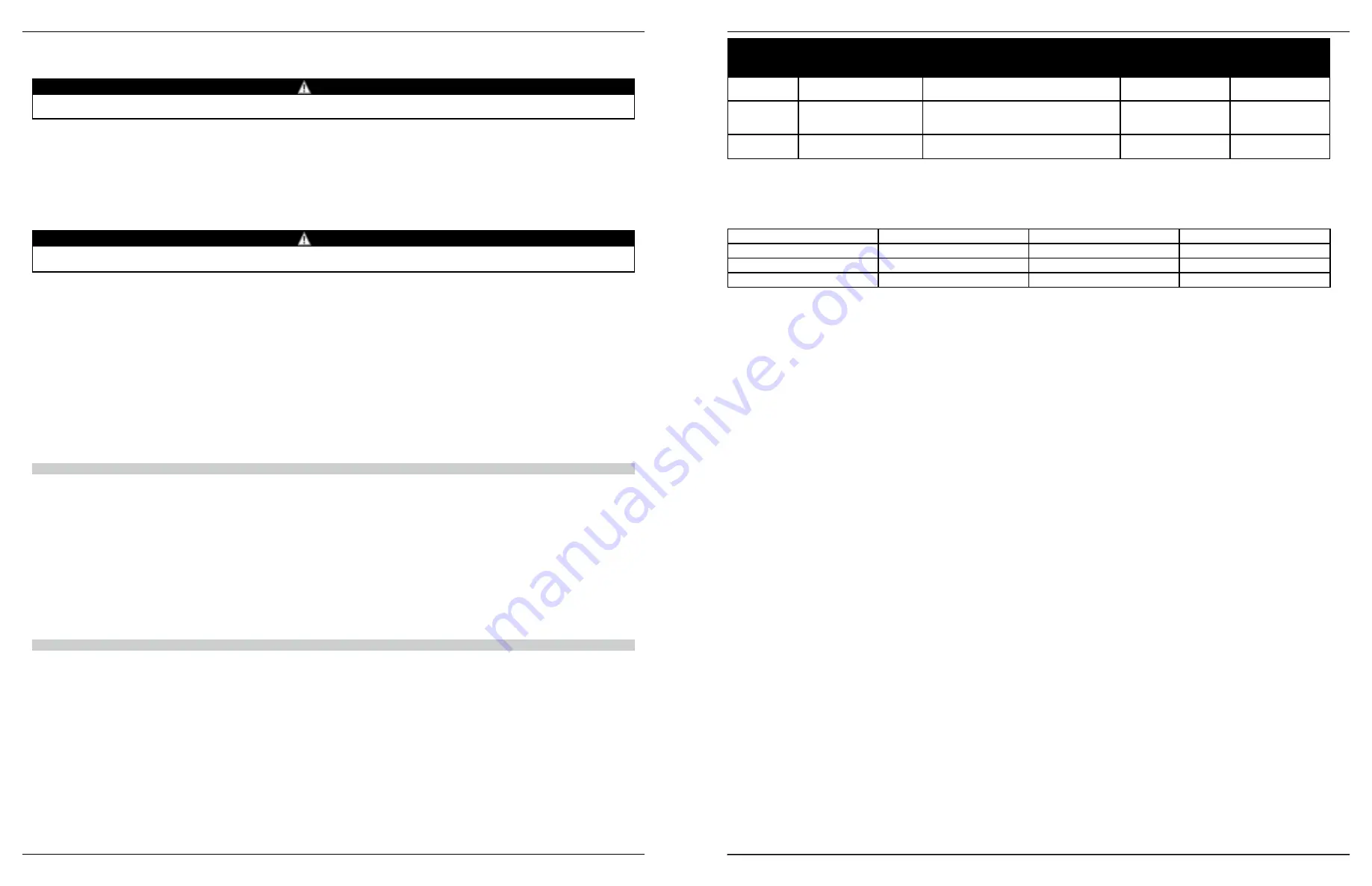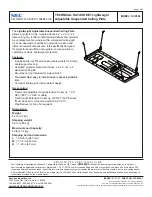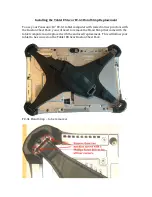
Page 20
Page 21
© 2018 MSA
© 2018 MSA
P/N 10147049
P/N 10147049
ENGLISH
(2) Lowering a personnel load: To lower a load with personnel suspended, rotate the crank handle counter clockwise. To extract line from the Winch when there is no suspended
load, rotate the handle counter clockwise while pulling on the line with at least 6.75 kg of force. To resume lifting, make clockwise revolutions of the crank handle.
(3) Suspending a personnel load: To suspend a personnel load, slowly release the crank handle. (4) Raising a personnel load: To raise a personnel load, rotate the crank handle
clockwise. A clicking sound will be heard as line is reeled in. When reeling in line, check to be sure the line wraps evenly and tightly around the drum.
CAUTION
In the event of a fall, lift before lowering to disengage the secondary brake pawls. Lift first at least one half turn of the drum before attempting to lower. Unless
the secondary brake pawls are disengaged after a fall, the winch will not pay out line.
(5) Acidic, alkaline, or other environments with harsh substances may damage the hardware elements of this MSA Workman Winch. If working in a chemically aggressive
environment, consult MSA to determine acceptable system components for your specific conditions. Chemical hazards, heat and corrosion may damage the MSA Workman Winch.
More frequent formal inspections are required in environments with chemical hazards, heat and corrosion. Do not use in environments with temperatures lower than -40°C and
greater than 54°C. Do not expose to corrosive environments for prolonged periods. Use extreme caution when working near energized electrical sources. Maintain a safe working
distance (preferably at least 3 m) from electrical hazards. When working near moving machinery parts (e.g. conveyors, rotating shafts, presses, etc.), make sure that there are no
loose elements in any part of the system.
9. Inspection guidelines:
All MSA products are inspected and tested under controlled conditions at the factory before shipment. User inspection, maintenance and storage of the
equipment take on added importance once the device is subjected to potentially severe environmental and work place conditions. Before each use the user should carefully inspect
the device by following the instructions and labels. Inspect the functioning of the device according to the instructions in this section and examine the unit for excessive wear, damage,
alteration or missing parts. The frequency of periodic inspection depends on the severity of environmental conditions and frequency of use of the unit. The results of this inspection
must be documented using the inspection forms at the end of this user instruction. The appropriate month and year on the inspection grid on the product must also be permanently
marked using a steel stamp, taking care to not damage the winch housing.
CAUTION
When a test load is needed to allow inspection of any winch function, do not use personnel as a load. Make sure the area below winch is free and clear of any
obstructions. Always inspect the winch functions prior to each use.
(1) Inspecting line payout and retrieval: Mount the winch to a suitable anchorage connector (such as the MSA Workman Tripod) to allow operation of the crank. Maintaining tension
on the winch line, rotate the crank counterclockwise to pay the line out. Then rotate the crank clockwise to check for proper line retrieval. A clicking sound indicates that line retrieval
is functioning correctly. Remove the product from use and return it to MSA if no clicking sound is heard. During line extraction and retraction, check that the winding guide wraps
the line tightly around the drum. (2) Inspecting handle: Check for cracks, bends and corrosion on the handle. Remove the product from use if any of these conditions are found and
contact MSA for a replacement handle. (3) Inspecting marking: Check for presence of all labels. Make sure all labels are clear (not damaged) and legible. (4) Inspecting bolts and
nuts: Using fingers check all bolts and nuts on the housing to ensure their tightness. If loose, tighten them. Check to see if any bolts, nuts or other parts are missing or have been
improperly substituted or altered in any way. (5) Inspecting installation bracket, housing and drum: Look carefully for signs of cracks, dents, deformation or ruptures in the housing,
drum and installation bracket. Minor dents which do not affect function do not require user action. Return for service if material cracks found. Accidently dropping the unit may lead
to some deformation of internal components. Check for signs that the press plate and drum are rubbing. This will be evidenced by wear on the drum flanges, also the user may
experience uneven resistance when rotating the crank handle. Whenever there is damage that prevents the winch from operating normally, remove the unit from use. Minor dents
or deformations which do not affect function do not require user action. (6) Inspecting the snaphook: Check all parts of the swivel snaphook for signs of alteration, distortion, cracks,
deep nicks, dents or cuts. Also check for indications that the snaphook has been subjected to intense heat which could affect its strength. Inspect for signs of corrosion or excess
wear and remove the product from use if there is any question whether detected wear and/or corrosion may affect strength or function. Check to see that the snap body swivels
freely around the bolt connecting it to the snap eye. (7) Inspecting line fittings: Cable: Check the two ferrules and the thimble. If the user’s unit has a splice as the means of attaching
the snaphook, the splice must be completely and tightly tucked with no loops or loose ends. Synthetic rope: Check the sewing thread which is inside of the bumper and the plastic
thimble. Whenever the sewing thread is damaged, remove the unit from use. The average lifespan of the synthetic rope is 10 years. However, the following factors can reduce the
performance of the product and its lifespan: incorrect storage, incorrect use, mechanical warping, contact with chemicals (acids and alkalis), and exposure to high temperature. More
frequent inspections are required in these environments. (8) Inspecting pulley: Check all parts of the pulley for signs of alteration, distortion, cracks, deep nicks, dents or cuts. Inspect
for signs of corrosion or excess wear and remove the product from use if there is any question whether detected wear and/or corrosion may affect strength or function. (9) Inspecting
carabiner: Check all parts of the carabiner for signs of alteration, distortion, cracks, deep nicks, dents or cuts. Inspect for signs of corrosion or excess wear and remove the product
from use if there is any question whether detected wear and/or corrosion may affect strength or function.
WARNINGS
A full body harness is the only acceptable body holding device that can be used in a fall arrest system.
A fall arrest system, MUST ONLY be connected to the harness back D-ring or front D-ring only with the fall arrest attachment tag “A”. These points can also be used for connecting
a rescue system. Never use the hip D-ring for fall arrest or climbing protection. The hip D-ring of a harness MUST ONLY be used for connecting a work positioning system (EN 358)
(Customs Union Technical Regulation TP TC 019/2011 ;Ukrainian standard: ДСТУ EN 361:2008) and NEVER a fall arrest system or climbing protection.
The MSA Workman Winch MUST be fully inspected before each use to verify that it is in serviceable condition. Examine every inch of the Workman Winch for severe wear, missing
or broken elements, corrosion, or other damage. Examine if label is missing or illegible; if there is evidence of improper function, improper fit, or alteration of any component. Do not
use MSA Workman Winch until confirmed in writing by a competent person if inspection reveals an unsafe condition. See inspection guidelines.
DO NOT modify or attempt repairs on the MSA Workman Winch. Only MSA or parties with written authorization from MSA may repair an MSA Workman Winch. The system shall not
be used outside its limitations, or for any purpose other than that for which it is tended.
Snaphooks and carabiners must not connect to each other. Do not tie knots in a lanyard. Do not connect two snaphooks to one D-ring. Do not rely on feel or sound to verify proper
snaphook engagement. Always check visually for proper engagement. Ensure that gate and keeper are closed before use.
Prevent denting or deformation of the housing. Never drop the unit from any height. Always set it down carefully. When in use, protect the line from contacting sharp corners and
edges. Prevent loops from forming in a slack line and being pulled tight, causing line kinking. Do not allow foreign matter to enter the housing. Do not permit the line to snag or be
crushed. Do not use where objects may fall or otherwise interfere with the operation or ability of this device to function properly.
It is essential for the safety of the user that if the MSA Workman Winch is re-sold outside the original country of destination the reseller shall provide instructions and additional
relevant information for use, for maintenance, for periodic examination and for repair in the language of the country in which the MSA Workman Winch is to be used.
Failure to follow these warnings or misuse can cause serious personal injuries or death.
MAINTENANCE AND STORAGE
Strictly adhere to the cleaning instructions in this section to prevent adverse effects on the materials used in the product.
Periodically use a clean, damp (not wet) cloth to remove dirt or contamination which may cause corrosion or hamper legibility of labels. Never use solvents to clean the housing as
they may break down the label adhesive. Use a clean dry cloth to wipe the line dry as it is slowly re-reeled back into the device. If necessary, lubricate the line after this operation.
Lubrication must only be applied to a clean, dry wire line because it is effective only when the dressing comes in contact with metal. If inspection reveals buildup of contaminants,
use a densely bristled fiber brush (not wire) to remove the contaminants. Never use gasoline or kerosene as a solvent. Pay particular attention to cleaning the gaps between the line
strands so lubricant can penetrate into the line core and fill these gaps to seal out moisture and foreign particles. Use a low viscosity field lubricant having moisture resistant, non-
corrosive properties. It may be applied by brush or swabbing with a cloth saturated with the lubricant. Wipe off excess lubrication with a clean dry cloth.
It is impossible to specify the time intervals between lubrications. However, the line should be properly lubricated at all times, and periodic inspections will indicate when it must be
done. In corrosive environments, the line should be cleaned and lubricated more frequently. If the winch is taken out of service for an appreciable length of time, the line should be
cleaned and lubricated before storage.
Note: Do not lubricate any part of the winch except the wire rope and the snaphook. The winch winding mechanism is virtually maintenance free. All bearings are lubricated for
life. The winch contains no user serviceable parts. Equipment which is damaged or in need of maintenance must be tagged as “UNUSABLE” and removed from service. Dispose
in accordance with local regulations. Corrective maintenance (other than cleaning) and repair, such as replacement of elements, must be performed by MSA. Do not attempt field
repairs.
MSA recommends periodic factory authorized recertification of mechanical devices according to the intervals in the table below. While this is considered best practice, it is ultimately
at the discretion of the competent person. MSA requires periodic competent person inspection by someone other than the user according to the intervals in the table below or local
regulations. This is not optional.
Type of Use
Application Examples
Conditions of Use
REQUIRED Competent
Person Inspection
Frequency
RECOMMENDED
Factory Authorized
Recertification
Frequency
Infrequent to Light
Rescue & confined space,
Factory maintenance
Good storage conditions, indoor or infrequent outdoor use, room
temperature, clean environments
Annually
At least every 2-5 years
Moderate to Heavy
Transportation, Residential construction,
Utilities, Warehouse
Fair storage conditions, indoor and extended outdoor use, all
temperatures,
clean or dusty environments
Semi-annually to annually
At least every 1-2 years
Severe to Continuous
Commercial construction,
Oil & Gas, Mining
Harsh storage conditions, prolonged or continuous outdoor use,
all temperatures, dirty environment
Quarterly to semi-annually
At least annually
AS/NZS 1891.4 requires a competent person inspection at least every 6 months. Additionally, service by height safety equipment inspector is recommended by MSA at least every 5 years.
Store the MSA Workman Winch in a cool, dry and clean place out of direct sunlight. Avoid areas where heat, moisture, light, oil, and chemicals or their vapors or other degrading elements
may be present. Equipment which is damaged or in need of maintenance should not be stored in the same area as usable equipment. Heavily soiled, wet, or otherwise contaminated
equipment should be properly maintained (e.g. dried and cleaned) prior to storage. Prior to using equipment which has been stored for long periods of time, a Formal Inspection should be
performed by a competent person.
Transport the MSA Workman Winch in a package to protect it from cuts, moisture, chemicals and their vapors, extreme temperatures, and ultraviolet rays.
Components and accessories list:
Item number
Part number
Description
Figure number in the manual
1
10116521
MSA Workman Tripod
42
2
506222
Pulley
41
3
10129888
Carabiner
40
ENGLISH











































